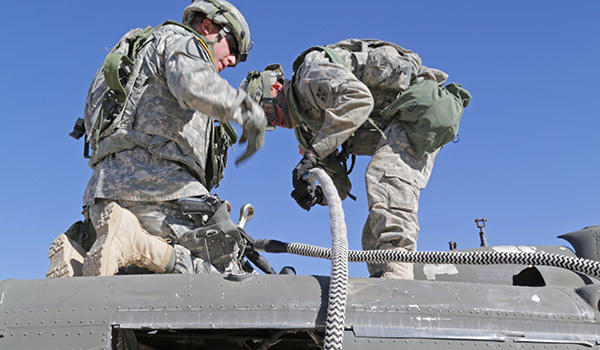
Aviation Branch Chief / By MG Michael D. Lundy: At night, terrain flight, five radios, multiple aircraft, 3 KMs a minute, marginal weather, brown out LZ, troops in contact… the 30 Soldiers in the back trust that we got training and leader development right.

SSG Anthony Agney from Delta Company, 1st Attack Reconnaissance Battalion, 4th Aviation Regiment, 4th Combat Aviation Brigade, checks to ensure the cables are properly secured to recover a downed aircraft during Decisive Action Rotation 15-03 at the National Training Center in Fort Irwin, CA, Jan. 24, 2015. Decisive Action rotations at the NTC ensure units remain versatile, responsive and consistently available for the current fight and unforeseen future contingencies. / U.S. ARMY PHOTO BY SGT CHARLES PROBST
This Blue Book edition of AAAA magazine features the leadership of the entire Army Aviation Team. The leaders that fill the pages today did not get here by chance. Along their path they were coached, taught and mentored by great leaders at all levels who clearly understood that their most important responsibility was securing the future of our Branch and Army.
Today’s Blue Book provides the perfect backdrop to reflect on what must continue to be our central focus – developing the Aviation Leaders who will fill these pages in the future, long after the current leaders have left the ranks.
With the high OPTEMPO and increasing world-wide demands on Army Aviation, we can easily lose sight of what’s important and focus too much energy and effort on the latest urgent crisis of the hour. Whether it’s in operational units, where most leader development occurs, or in the institution or through self-development, the future of our branch and our Nation requires all of us to maintain a consistent and persistent focus on continuing to develop both ourselves and our future Warrior Leaders.
Sometimes that means taking risk on the latest hot thing that’s in the in-box to ensure that we make the personal investment in our most important weapon systems. Quality time – that’s what it takes and it’s up to all of us to give all that we can to the development of our subordinates. In the end, you’ll find the urgent requirements become fewer as your subordinate leaders increasingly shoulder the weight of responsibility.
Army Aviation leader development is a deliberate, continuous and progressive process, grounded in the Army values to mature our junior leaders into committed and highly competent leaders of character. To prevail in the unknown and unknowable future operational environments that the Army Operating Concept portends, our leaders must be forged in tough, realistic and physically and mentally rigorous training in Combined Arms Maneuver. Our future leaders require even greater knowledge, skills and experience than leaders of the past, and the only way we get there is through tough, realistic training and leader development.
The future success of the Aviation Branch and our Army lies in our future leaders, not the next best piece of technology. Always train the way we fight and be all in by giving up your most precious resource to your Soldiers and leaders – your time.
Above the Best!
MG Michael D. Lundy is the Army Aviation branch chief and commander of the U.S. Army Aviation Center of Excellence and Fort Rucker, AL.










